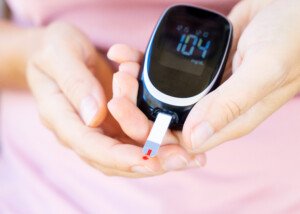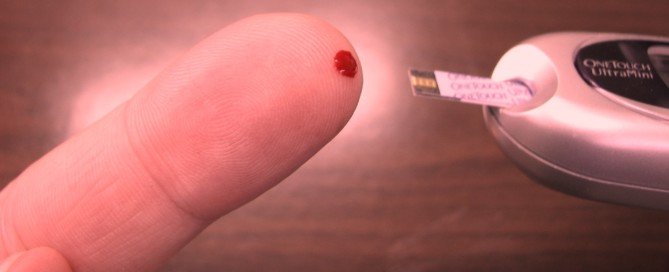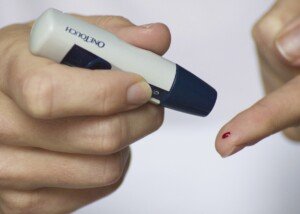How to Eliminate the Spinach Taste in a Spinach Smoothie

I accidentally discovered a way to greatly blunt the spinach taste in a spinach smoothie despite loads of spinach in the blend!
Recipes for spinach smoothies often call for small amounts of this green superfood because it’s quite unpalatable in liquid form for many people.
But there IS a way to cram a LOT of spinach into a smoothie.
In fact, here’s a way to create a large smoothie that’s virtually ALL spinach — without hardly tasting any of it. No kidding!
And why make a spinach-full smoothie if you don’t want to taste the spinach?
Because this vegetable is a superfood: full of health-giving nutrients.
How to Practically Neutralize the Spinach Taste Despite a Ton of Spinach in Your Smoothie

Use a NutriBullet or NutriNinja processor. This recipe will not work with “juicers” or juice extractors.
Place an apple slice or small amount of any other non-leafy produce at the bottom, as depicted in the image above.
This will prevent spinach leaves from sticking to the bottom (which becomes the top when you flip it over to process).

Cram as much spinach as possible up to the black limit line of the container.
You can breach this rule a little, as I’ve done here, as I’ve done in the image above.
Don’t just drop in the leaves. Cram and stuff them down with your fingertips so that the volume is compact.
Cram as much as possible up to or a little past the black line. Then add a small palm-full of raw almonds.

Add water to a little past the black line or marker. Then turn on the NutriBullet or NutriNinja.
Let it grind away for at least 60 seconds. The machine will NOT overheat or malfunction.
You want to be sure to completely pulverize the almonds and leaves. The result will be a rich green color.
I like to pour the contents into a very large glass, like the huge stein shaped glass below.
There will be a LOT to drink, due to the required water content.
If you don’t add enough water, the drink will be thick like a shake. If you prefer this, then fine.
But I like to get green smoothie ingestion over as fast as possible, and the only way to accomplish this is to have a thinner drink so that I can easily guzzle a lot in a long breath.

Add one and a half tablespoons of the following to the drink (which can be purchased in ground form):
- GROUND chia seeds
- GROUND flaxseeds
- The seeds do not have to be processed by the NutriBullet or NutriNinja. They will easily mix into the processed product.
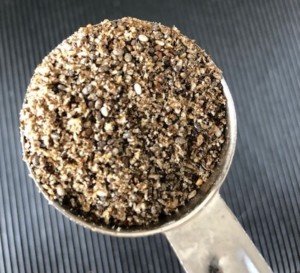
Ground chia seeds (above)

Ground flaxseeds
Stir vigorously with an object that reaches the bottom of the glass, such as a butter knife. If it seems too thick (not easily “guzzable”).
Then add water and stir in. It’s never too late to add more water to thin out the beverage.

Now I’m not exaggerating when I say this, but you will hardly — and I mean barely, if at ALL — taste the spinach.
So what, then, will you actually taste? First of all, the taste will be highly tolerable. It will totally lack that unpalatable, awful taste of earth and mud that some people describe as the taste of liquified spinach.
Depending on what other produce you put at the bottom (to prevent the leaves from sticking), it will be a bland, weak taste, almost like nothing.
If you use grapes instead of an apple, you’ll taste the grapes, not the spinach, and the drink will have more flavor, but it will still be weak.
With an apple slice, it will almost be neutral, actually. It will not taste like cardboard or paper.
Trust me, you will easily tolerate it. You will not have to plug your nose as you drink this spinach smoothie, nor will you dread your next sip or guzzle.

Strangely, it will not taste nutty or seedy. You may detect a vague taste of almonds.
But what happens is that the almonds and seeds cancel out the taste of the spinach, and the spinach cancels out the taste of the almonds and seeds. It’s really strange, but it works.
You can now drink large amounts of spinach without ever gagging on the taste ever again!
 Lorra Garrick has been covering medical, fitness and cybersecurity topics for many years, having written thousands of articles for print magazines and websites, including as a ghostwriter. She’s also a former ACE-certified personal trainer.
Lorra Garrick has been covering medical, fitness and cybersecurity topics for many years, having written thousands of articles for print magazines and websites, including as a ghostwriter. She’s also a former ACE-certified personal trainer.
.
Top image: ©Lorra Garrick
How to Walk Faster if You’re Elderly

Elderly people are notorious for walking very slowly, but this doesn’t mean it has to be so.
Slow walking does NOT have to be a non-preventable effect of old age. Furthermore, the ability to RUN need not disappear in senior age. (more…)
What Kind of Hard Candy Is Okay for Diabetics?

There’s all sorts of yummy hard candy out there, and being diabetic doesn’t mean you can never enjoy this kind of sweet food ever again.
With all the types of hard candy sold at candy stores, grocers and online, is there a particular kind that’s best for a person with diabetes? (more…)
What Can Cause Blood Sugar to Spike Overnight?

Sudden spikes in blood sugar overnight are something that diabetics don’t want to ever experience.
Something like this happening – blood sugar soaring while you’re sound asleep and totally unaware – is a frightening thought. (more…)
How High Must Blood Sugar Be for Emergency Room Visit?
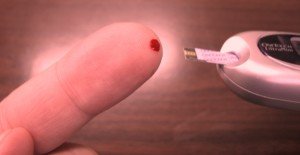
How high must that number on the glucose meter be in order for it to warrant a trip to the emergency room STAT?
Should you zip to the emergency room if your blood sugar is over 300 no matter how you feel? (more…)
How to Tell if You’re Urinating Too Often from Diabetes

One of the classic symptoms of untreated diabetes is the so-called excessive urination. (more…)
Hip and Butt Pain Caused by Treadmill Walking: Solutions

Believe it or not, walking on a treadmill may be the cause of your hip and butt pain, even the tingling that comes with it.
At the epicenter of this problem is the piriformis muscle. (more…)
Can Low Blood Sugar Cause Muscle Twitching?

When a person lately begins suffering from a lot of unexplained muscle twitching, they may try to convince themselves it’s low blood sugar because this diagnosis would sure beat a diagnosis of ALS. (more…)
All the Smells Associated with Uncontrolled Diabetes

There are different ways that uncontrolled diabetes can make your body smell.
And these odors are not the same, depending on where in your body they are coming from.
Diabetes and Breath Smell
“Breath can smell due to chemical changes,” says Susan L. Besser, MD, with Mercy Medical Center, Baltimore, and Diplomate American Board of Obesity Medicine and board certified by the American Board of Family Medicine.
“Uncontrolled diabetes causes the body’s pH to be off (usually more basic than acidic) which can cause unusual breath smells,” says Dr. Besser.
When blood sugar rises to unacceptable levels, the body is forced to break down fat for energy – and this is more fat than what the body normally breaks down.
The body also breaks down muscle (catabolism) – which it is never supposed to do.
The body’s preferred fuel source is glucose (blood sugar).
When the supply of glucose runs out, the breakdown of fat and muscle causes the blood to become acidic due to chemicals called ketones in the blood.
These ketones can make the breath have a chemical odor because the body is trying to get rid of the ketones via exhaling.
Well of course, when one exhales, their breath comes out; hence the detectable odor.
The chemical odor resembles nail polish remover because the compound in nail polish remover is acetone.
However, the breath may also smell somewhat fruity or sweet.
Diabetes and Urine Odor
“Urine odor can be sweet because of the large amount of sugar in the urine,” says Dr. Besser. This condition is called glucosuria.
The body is trying to reduce the excess sugar in the blood by expelling it via urine.
Excess ketones in the urine can also yield a sweet or acetone odor.

Shutterstock/Africa Studio
Feminine Odor from Diabetes
During menstruation, a sweet or unusual odor may arise due to the pH being off with uncontrolled diabetes.
“Additionally, uncontrolled diabetics can develop yeast infections — either vaginally or on skin due to the pH changes and higher sugar concentration in menstrual fluids and sweat,” says Dr. Besser. “Yeast thrives in that environment.”
Can diabetes affect the smell of hair?
Dr. Besser adds that she is not aware of any way that uncontrolled diabetes can affect the smell of one’s hair.
But if you’ve noticed that your hair has a naturally sweet or syrupy scent, you can assume that this is due to its natural oils – oils that don’t originate on the hair shaft itself, but in oil glands under the scalp.
 Dr. Besser provides comprehensive family care, treating common and acute primary conditions like diabetes and hypertension. Her ongoing approach allows her the opportunity to provide accurate and critical diagnoses of more complex conditions and disorders.
Dr. Besser provides comprehensive family care, treating common and acute primary conditions like diabetes and hypertension. Her ongoing approach allows her the opportunity to provide accurate and critical diagnoses of more complex conditions and disorders.
 Lorra Garrick has been covering medical, fitness and cybersecurity topics for many years, having written thousands of articles for print magazines and websites, including as a ghostwriter. She’s also a former ACE-certified personal trainer.
Lorra Garrick has been covering medical, fitness and cybersecurity topics for many years, having written thousands of articles for print magazines and websites, including as a ghostwriter. She’s also a former ACE-certified personal trainer.
.
Top image: Shutterstock/Aaron Amat
How Dangerous Is Blood Sugar in the 200’s?
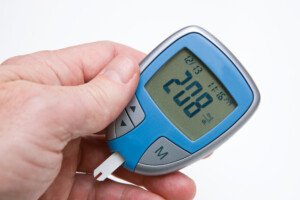
Under certain conditions, a blood sugar reading in the 200’s can damage the body’s organs.
The longer that your glucose (blood sugar) remains very high, the more likely it will cause a lot of problems – and this includes blindness. (more…)













